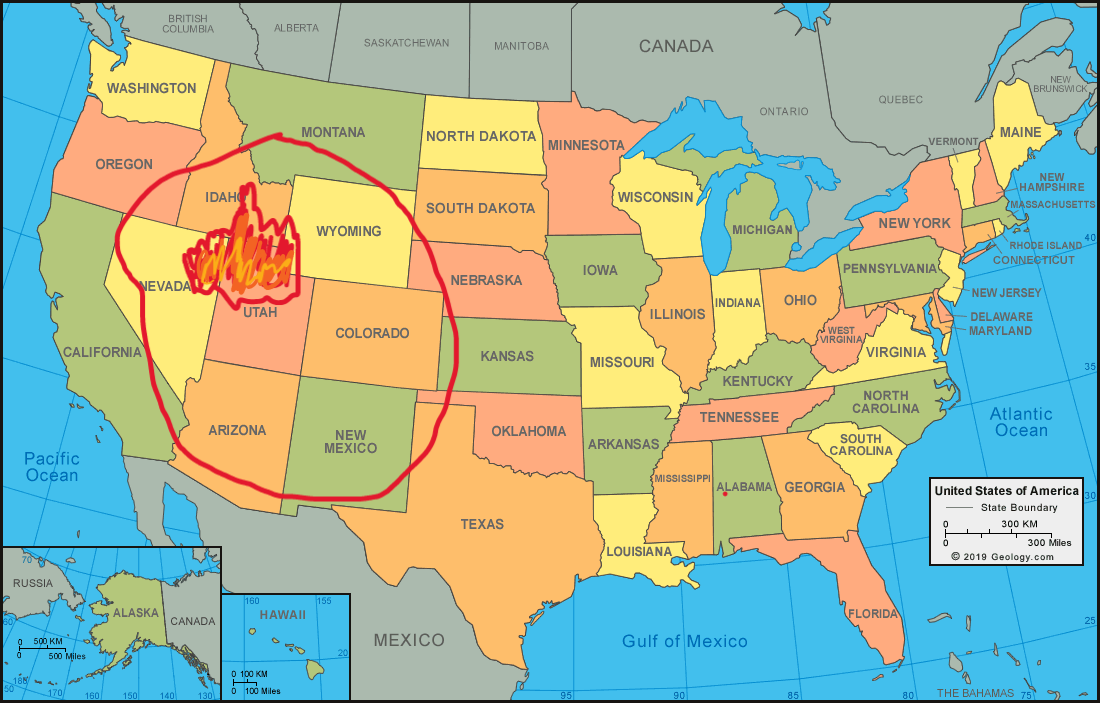#EAPS#EAPS106
A wildfire is an uncontrolled fire in an area of combustible vegetation that occurs in a wilderness area, such as a forest or grassland.
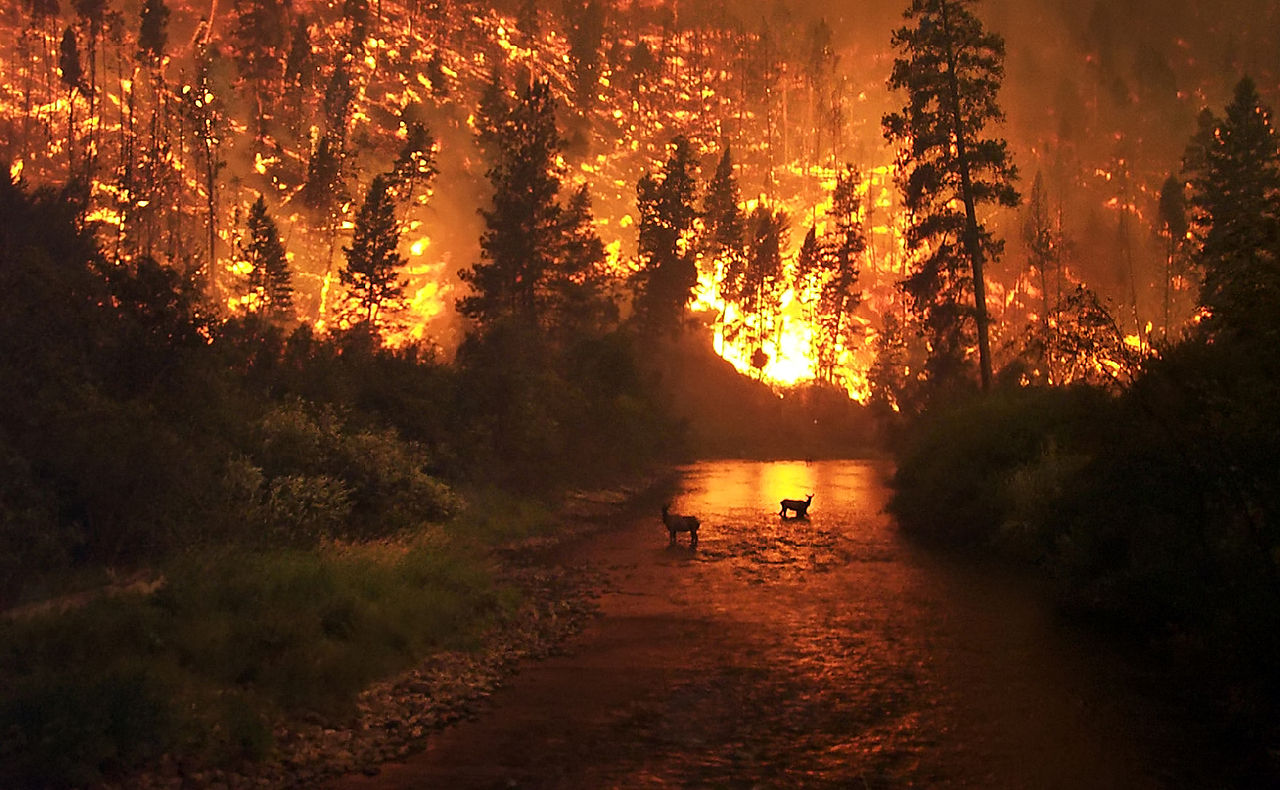
- Animals are actually pretty smart when it comes to fire, they know where to go to avoid it
Wildfires and How they spread
- Fire is an exothermic (heat producing), self-perpetuating, chemical reaction initiated by a small amount of heat
- This process causes fuels to be combined with oxygen leading to new compounds, a lot more heat, and light
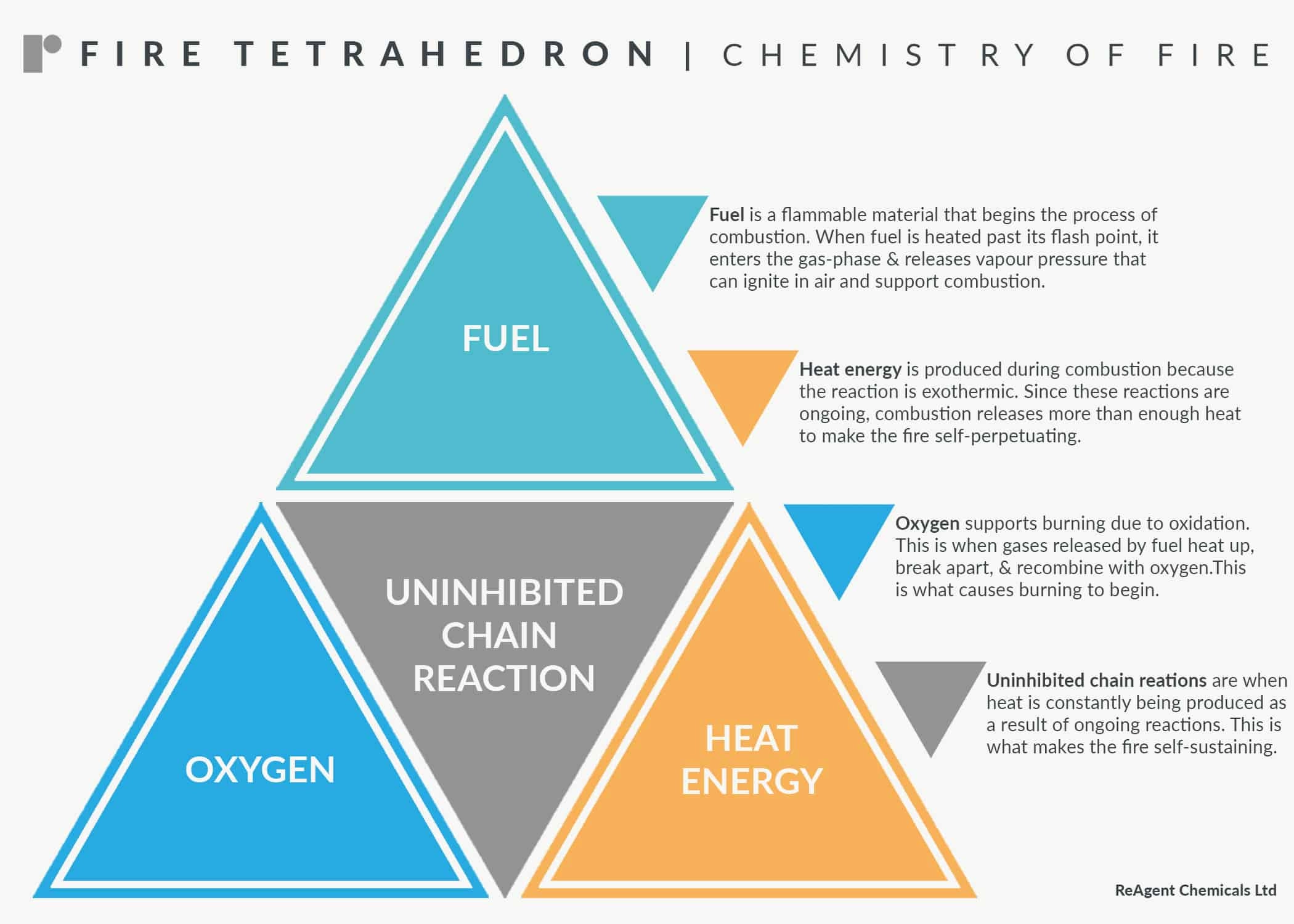
- Three main phases of a wildfire
- Preignition
- Heat causes fuels to begin to thermally decompose and give off flammable vapors
- Combustion
- Smoldering
- Ash cover leads to slow, low temperature burning and inhibits new fuels from lighting
- Preignition
- Surface fires involve grasses, pines needles, and shrub. The large surface area to volume ratio of these fuels allow them to burn more easily and spread more rapidly.
- Crown fires are those in which flames reach the top (crown) of trees where fine branches and needles can burn very rapidly. They are the hottest and fastest moving of all wildfires and extremely difficult to fight.
- Crown fires can burn out a large cluster of trees in less than a minute
- 85% of all wildfires in the U.S. are caused by humans. The rest are caused by lightning.
- There are many ways we can cause wildfires
- Debris burning, campfires, smoking, equipment, arson, power lines, ash disposal
- Humans may cause the most fires, but wildfires started by lightning actually burn more acres
- Lightning fires tend to
- Occur in more remoter areas
- Burn longer before being noticed
- Are more difficult to fight
- Often left to burn as a natural process
- The potential for a wildfire to spread to larger fires is influenced by the type of vegetation. Desert shrubs have the most potential for large burns, and they’re usually in the Western United States.
- It can also be influenced by the amount of rainfall. Less rainfall means dryer fuels and larger burn potential. The east coast gets a lot more rain, so a lot less fires.
- Higher temperatures mean dryer fuels and larger burn potential. Usually this is in the Southern U.S.
- Topography can also affect it. Fires burn faster uphill, so steeper slopes increase the potential for fires to spread. There is a lot more mountainous and uphill areas in the West.
- Putting all of these things together, the Western United States has the highest potential for wildfires to spread into large fires.
- When driven by strong winds, dry shrubs and chaparral can be amongst the hottest, fastest, and deadliest moving fires.
Wildfire History, Policy, and Benefits
- The Great Fire of 1910
- The largest wildfire in U.S. history, burned 3 million acres in the Northwest in two days
- Killed 87 people, including 78 firefighters
- Marked the beginning of a concerted effort by the National Forest Service to fight all wildfires
- Ed Pulaski was a forest service ranger who saved most of his 45-man hotshot crew during the Great Fire of 1910 by bringing them to an abandoned mine and threatening to shoot anyone who left
- Ed Pulaski also invented what would be called the Pulaski axe, a single bladed axe with a grub hoe for scraping the ground clear that is now standard issue for all wildland firefighters
- Following the disastrous Great Fire of 1910, the US Forest Service’s original response to wildfires was to aggressively fight all wildfires.
- The consequence of aggressive fighting all wildfires is the prevention of natural fires from inhibiting the buildup of fuels, eventually leading to catastrophic fires
- Forest service stops the surface fires from burning up the fuel, which adds MORE fuel for future fires
- In typical forests, every year without fire adds the equivalent of 300 gallons of gasoline per acre
- Aggressive fighting all wildfires led to a significant buildup of trees in Yosemite Valley
- The CURRENT policy is to let them burn in primitive areas unless they endanger people or structures
- In 1972 the Forest Service shifted its policy of fighting fires from suppression to mitigation and management
- Permit wildfires to burn in wilderness areas to reduce fuel buildup and support natural ecosystems
- Only light fires that endanger people or important structures
- Fire is a natural part of nature, its important
- 10 years after the Yellowstone fires, Lodgepole pines reestablish themselves amongst still standing dead trees. Fire is required for the pinecones to germinate.
- Grass tends to survive fires more easily
- Ancient hunters set fires to maintain grasslands and prevent trees and shrubs from taking over.
- Grasses can survive fire because they can regrow from the roots, while trees and shrubs cannot
- Seasonal natural grassland wildfires in Africa help maintain the grasslands
Fighting Wildfires
- Direct Attacks
- Any treatment applied directly to burning fuels
- Wetting
- Chemically quenching
- Smothering
- Indirect Attacks
- Treatments applied around and in front of burning fuels
- Fireline construction
- Backburns
- Wetting unburnt fuels
- Directing fires towards areas that will not burn (streams, roads, fire-resistant trees like birch and fir trees)
- The frontline fighters of wildfires are Hotshot crews
- 20-22 wildland firefighters in each crew
- Trained and equipped to fight the most challenging tasks of fire fighting in remote areas for extended periods of time with minimal logistical support
- Organized by federal and state agencies such as the Forest Service, National Park Service, and Bureau of Land Management, but not by municipalities (cities or towns)
- A fireline is a means to cutoff fuel to a fire
- in brush the objective is to remove brush and scrape down to the soil along a wide line so that a surface fire cannot pass
- In a timber fireline a swath of trees and brush s removed, low branches are cut (called limbing up) to prevent spread of a surface fire into tree canopies, and a brush fireline is constructed to prevent the spread of a surface fire
- Backburns remove fuel from the path of a fire by burning it
- This is where the phrase “fighting fire with fire” comes from
- Accomplished in conjunction with a pre existing fireline
- Air tankers are fixed-wing aircraft fitted with tanks that can drop water or other fire retardants on wildfires
- The U.S. Forest Service uses nearly 1,000 firefighting aircraft each fire season
- Fire retardants are colored red to mark where they have been dropped
- With a capacity of over 20,000 gallons, the Evergreen 747 Supertanker is the largest air tanker in the world
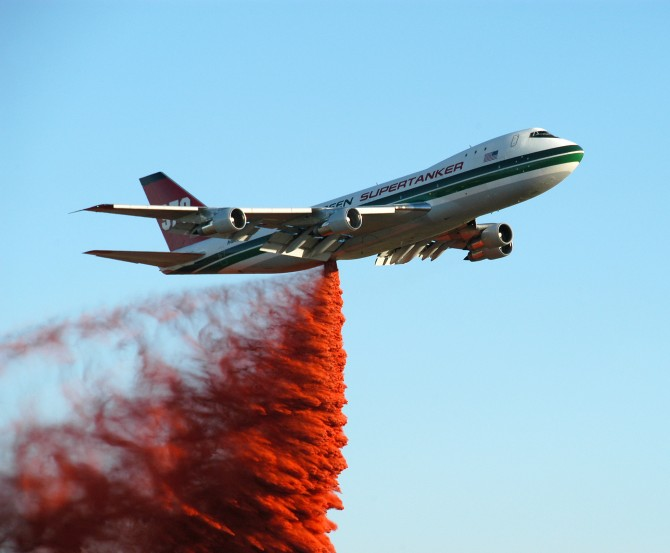
- A lot of these planes are old commercial planes that have been refitted
- The first air tanker was a crop-duster called the Single Engine Air Tanker. SEAT
- The first air drop was made on the Mendenhall, California fire in 1955
- Most air tankers drop their loads ahead or to the sides of the fire to prevent its spread. Dropping directly on the fire is usually less effective as the heat can cause the evaporation of the water or retardant before it hits
- The pilots of airtankers must be incredibly skilled to make low, slow, precise drops especially in mountainous regions
- Air tanker seaplanes can refill in lakes or reservoirs
- Helitankers - helicopters retrofitted to do similar drops
- Advantages over air tankers
- More specific targeting of drops
- Can refill in small bodies of water
- Can carry water cannons like a fire truck
- Disadvantages
- Shorter range to drops
- Carries less water or fire retardant
- Advantages over air tankers
- There is always one tanker keeping its load ready in case they need to drop it to save a hotshot crew that got trapped
- Smoke Jumpers
- Best of the best, the elite
- Parachute out of planes into the fire area
- They create natural firebreaks
- The main purpose of smoke jumpers is to get to and fight remote wildfires before they become too destructive
- The idea came form the Blackwater fire of 1937, they couldn’t get some people out to fight the fire fast enough. So they decided to start dropping people in from the air
- Their parachutes deploy as soon as they jump
- They don’t jump directly into fires and don’t jump to save people
- There are about 400 active smoke jumpers in the US (30 are women)
- How do a few somke jumpers fight large remote wildfires?
- Arsenal
- Chain saws, Pulaski axes, and shovels to cut firelines
- Hoses and pumps to dowse fire with stream water
- Air tanker drops the equipment
- Strategy
- Attack the fire from the back and work up to the sides to limit it form spreading laterally
- Attack the head by quenching it, using a backfire, or steering it to unburnable areas
- Best progress is made at night when temperatures and winds drop
- Constant vigilance with spot fires
- Arsenal
The Dangers of Fighting Wildfires
- The most common cause of death for wildland firefighters is actually heart attacks
- More than 1000 U.S. wildland firefighters have been killed since 1910
- The top cause of death is heart attacks, demonstrating how rigorous the job remains
- It’s not by a runaway amount, many other things also cause fatalities like plane crashes, falling trees, and being overrun by fire
- A falling tree is known as a snag
- Twelve firefighters died when overrun by a fast-moving brush fire racing up a ridge during the 1994 Storm King Fire in Colorado
- Fire shelters or safety device of last resort used by firefighters when trapped by wildfires. It is designed to reflect heat and trap breathable air.
- Fire shelters are not designed to protect against direct, sustained contact with flames - they can protect against 2000 degrees Fahrenheit for up to only 1 minute. Therefore, firefighters need to clear the deployment area of fuels before deploying
- Doesn’t really stop heat from fires directly on the shelter, but can protect from most of the radiant heat from fires around
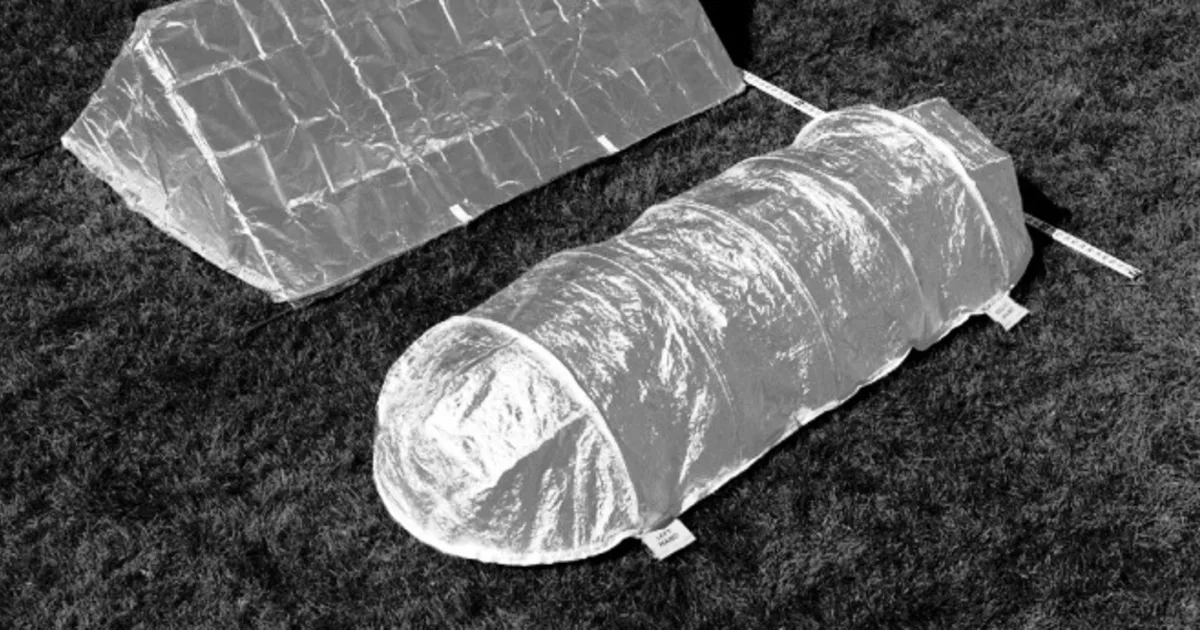
- The Granite Mountain hotshots
- They were overrun by the Yarnell Fire after they descended from a “black” (already burned) region toward another safety zone. They never made it.
- Though they cleared some of the area round them of fuels, the fire was too hot for their fire shelters to protect them
- What went wrong?
- A sudden downdraft changed the direction of the fire
- The crew did not have GPS to relay their exact coordinates
- The air tanker flying above did not know their location
- Nobody knows why they descended out of the safety of the black
